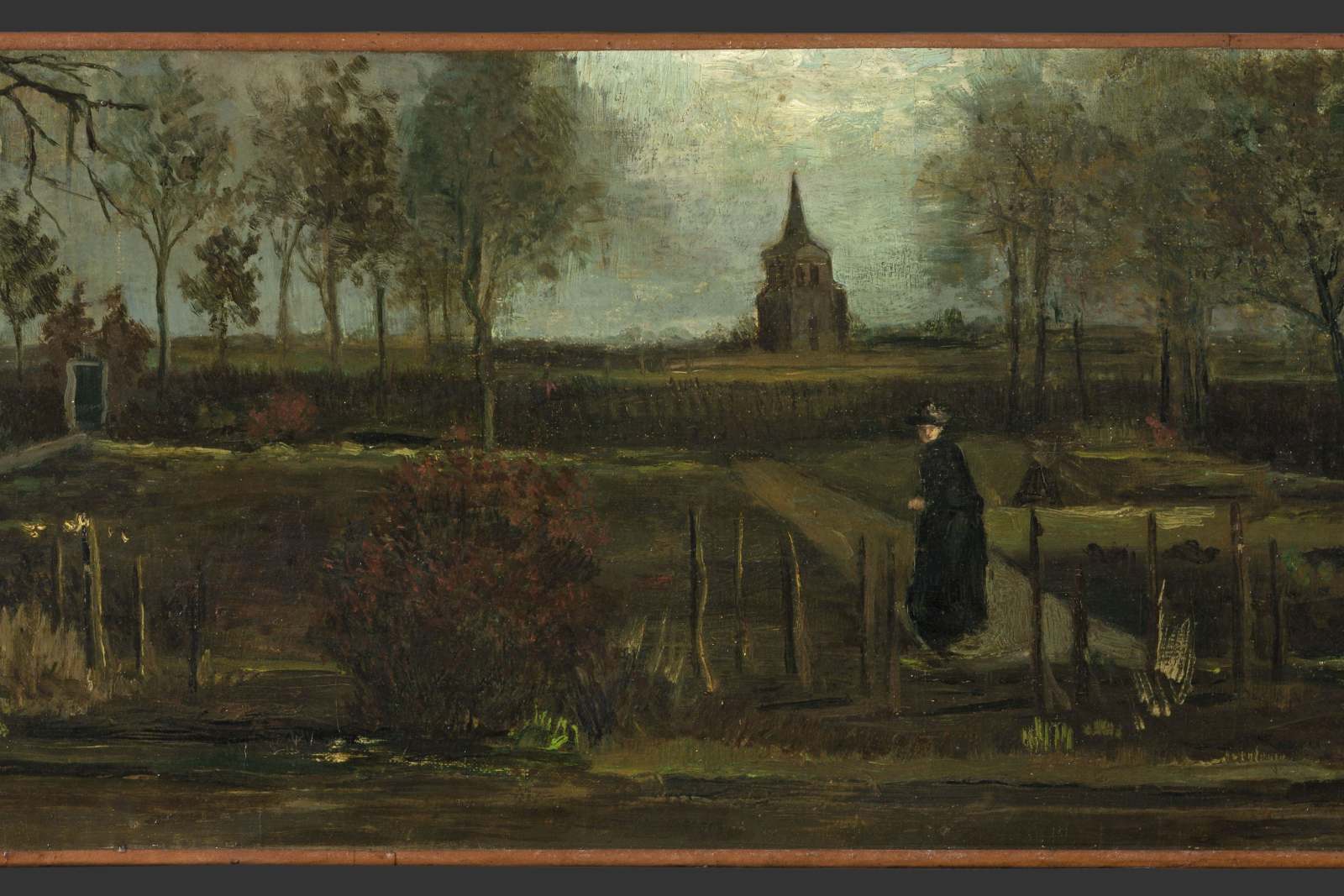What do you do with a stolen Vincent van Gogh painting?
by Nina SiegalThe televised security footage clearly showed the man smashing glass doors at the Singer Laren Museum, then walking out moments later with a painting by Vincent van Gogh under his arm.
"Look at that," Octave Durham said as he watched. "His gear is not even professional. If you're a professional you're fully in black. He's got jeans and Nike sneakers on."
Durham's exasperation is not that of some couch potato who has seen one too many crime shows. He's a thief who 18 years ago stole not one but two van Gogh paintings from Amsterdam's famous Van Gogh Museum.

One of two burglars convicted of the crime in 2004, he served just over 25 months in prison. In 2016, Italian police found the two paintings he stole in the kitchen wall of a house in the town of Castellammare di Stabia, near Naples, belonging to Raffaele Imperiale, a member of an Italian drug trafficking gang. They were returned to the museum.
"This is the easiest art heist I've ever seen," Durham, 47, concluded of the Singer Laren theft, which took place in the early morning hours of March 30.
Police in the Netherlands declined to comment on their investigation. But Arthur Brand, a private art crime detective who has helped recover many stolen artworks, said that he was working with the police on the case and that he saw some similarities in this theft and Durham's crime.
Both were quick break-ins, committed in under five minutes by men with a sledgehammer. Both the painting stolen from Laren, The Parsonage Garden at Nuenen in Spring, and one of those taken by Durham, Congregation Leaving the Reformed Church in Nuenen, depict the church where van Gogh's father served as pastor.
"My strong suspicion is that this is a copycat," Brand said. (By the way, he has verified that Durham was in the hospital at the time of the theft.)
Durham, who goes by the nickname Okkie, doesn't like the copycat theory. "People say he's an 'Okkie wannabe,' but I don't know," he said in an interview. "I wouldn't do it this way."
Now the thief is in very much the same situation as Durham was decades ago. What to do with a stolen van Gogh? Who buys a painting widely publicised as stolen?
"I just did it because I saw the opportunity," Durham said. He noticed a window at the museum that he thought would be easy to smash. "I didn't have a buyer before I did it," he said. "I just thought I can either sell them, or if I have a problem I can negotiate with the paintings."

By "negotiate with the paintings," Durham meant using the paintings as a bargaining chip with law enforcement officials, in case he got into trouble for something else.
Durham has been charged several times with thefts and break-ins, including a bank job for which he was acquitted but he now admits he committed. He has in recent years spoken a good bit about his past, agreeing to participate in a 2017 documentary about his life.
In a 2018 biography, Master Thief, by Wilson Boldewijn, Durham confessed to committing other thefts as well, but insisted that he never committed any violence against people to commit his robberies. (Under Dutch law, criminal prosecution records are sealed.)
"My No. 1 rule is talk smooth, be cool, have a fast car and never touch anyone," he said.
Durham said that, growing up, a neighbour of his had been a Dutch criminal: Kees Houtman, who had returned two stolen van Goghs in his possession to the Dutch judiciary in 2005, hoping to get a lighter prison sentence in a drug smuggling case. The early van Gogh works had been stolen from another small museum in the Netherlands, in 1990. Durham said, "That always stayed in my mind."
Durham said he first offered the van Gogh paintings he had stolen to two criminals, but both of them were murdered before the deal could go down.
"I'm religious, and I'm superstitious," Durham said. "I thought that these two paintings were cursed. I said, 'I don't want to do anything with these paintings.'"
Ultimately, he and his co-conspirator, Henk Bieslijn, sold the paintings to Imperiale, who owned an Amsterdam coffee shop and was a leader of the Camorra drug ring in Naples. He took the paintings to Italy and hid them in his mother's kitchen, apparently for safekeeping, according to Willem Nijkerk, a prosecutor with the Amsterdam public prosecutors office.

Meanwhile, Durham ran from Amsterdam to Spain, where the police arrested him in 2003 in Marbella, a southern resort town. Dutch forensic investigators were able to match DNA from a baseball cap he left behind at the Van Gogh Museum to convict him, but he refused to reveal the location of the paintings.
More than a decade later, when Italian police were investigating the Camorra Mafia family, Imperiale confessed by letter to having the paintings, in apparent hopes of negotiating a more lenient sentence for himself.
At least 34 van Goghs have been stolen worldwide since 1975, said Nienke Bakker, a senior curator of van Gogh paintings for the Van Gogh Museum. That number includes 20 paintings stolen in 1991 from the museum where she works; they were recovered within a few hours, from an abandoned car.
Ursula Weitzel, the lead public prosecutor on art crimes for the Netherlands Public Prosecution Service, said that in general, art is stolen for the same reasons people steal cars.
"Unless it's a crime of passion, usually the motive is to make money," she said. "It's as simple as that. People don't steal it because they want to hang it on the wall. That kind of theft for pride or status, I haven't seen that. It's usually for money. Or, for safekeeping, in the event that it may be necessary."
Brand said many thieves think they will be able to sell paintings on the open market, and then quickly discover that there are not legal buyers.
"More than half of my cases have been like that," he said. "You have thieves who think there are buyers who would really like to have stolen art on their wall. That doesn't exist; that is only from the movie 'Dr. No.' But some thieves think these people exist, and then they have a rude awakening when they can't sell the work."
That's when they offer them to other criminals, he said, often for much less than their real value.
Brand estimates that a work of art in the criminal underworld is worth about 10 per cent of its value in the legitimate art market — so if a painting might sell for $10 million at auction, it can be traded among criminals for a value of about $1 million. Durham said the value is even lower than that — about 2.5 per cent to 5 per cent of market value.
Weitzel, who handles about 10 cases of stolen art a year in Amsterdam alone, said sometimes a criminal might hold on to a work in hopes of using it as collateral or a bargaining chip with law enforcement authorities.
"In the end, it's an investment, even if it's an illegal investment," Weitzel added.
It often take decades before stolen paintings resurface, and few works, less than 10 per cent of those stolen are returned, Brand said. In cases where paintings are worth millions, the chance that the works will finally be returned is significantly improved. "It's still not very much," he said. "My guess is that people destroy less valuable art because they can't do anything with it."
The Singer Laren painting, an oil-on-paper work from 1884, was on loan from the Groninger Museum in the northern Netherlands.
Durham said he would not steal another van Gogh, and described the theft 18 years ago as the act of a younger man.
"It's not like doing a bank job," he said. "I understand now that people really like art, and if you steal it people are going to get mad and get hurt. I understand that now, even if I still don't have that feeling myself."